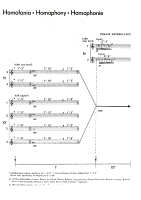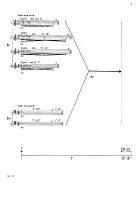Homophony for 4 trumpets, 4 horns, 4 trombones, piano and gong (1970)
Homophony is a very compact and coherent though by no means uniform composition. Its calm and static music does not lack moments of clashes or intense discharges. A more detailed analysis reveals that the main idea of the piece is to seek an equilibrium and order. Successive parts of the work logically stem from the preceding ones, and thus all contrasts turn out to be always fully justified. An important role is played by minor third tremolos as well as repeated passages the main component of which is also a minor third. They all make up a colourful patch of sound.
The composer very sensitively balances out the weight of the various elements of the work, thanks to which its progression, despite some “deviations”, seems to be unwavering. He achieves this effect thanks to a strong foundation in the form of long, repeated notes of irregular duration. The choice of the pitches is also linked to a minor third interval that comes from two diminished chords: B-D-F and G-B flat-D flat. It is exactly in harmonic and not temporal phenomena that the continuity of the work gets “disrupted”, for all notes from outside a six-note scale turn out to be dissonant. The dominant role of harmonics means that even when long chords do not appear (in number 28), an impression of continuity is conveyed by trombone tremolos on notes that belong to the scale.
An extremely important element of the work’s structure is symmetry. It occurs not only in the structure of the scale, but also on the level of micro- and macroform. We can observe it in freely accelerated and then decelerated short tremolando modules as well as in larger sections of the composition. For instance, from number 14 onwards, new material appears in the piano part after a surprising, sudden swell. Over a section of eighty seconds it undergoes a symmetrical crescendo (up to ffff ) and decrescendo (to mp). The composer uses a similar device at the end of the piece (numbers 30 and 31). We are dealing with a slow, minute-long crescendo built on irregularly repeated chord notes (from pppp to mf), followed by a decrescendo returning to pppp. In another fragment (numbers 23-27) the material presented pianissimo at the beginning is repeated fortissimo, only to return once again both in pp and in ff.
Symmetry is very much in evidence across the whole form as well. The volume gradually increases until a climax, which occurs approximately half way through the work (number 18), at the height of a piano crescendo. This climax is prolonged in a very interesting manner in numbers 24 and 26, which represent not so much a reminiscence but a second phase. This, however, does not upset the work’s general “equilibrium”, the post-climax phase of which unwaveringly, though not linearly, heads for silence, from which the composition originated.
“Homophony” means “same sound” in Greek. It denotes a single voice accompanied by chords. The term originated as an antonym of polyphony, i.e. simultaneous sounding of several equal voices. However, Sikorski understands “homophony” in very broad, even metaphorical terms. It is not only a type of texture or compositional technique, but a force that is common in nature, a force that, on the one hand, seeks equilibrium and, on the other, constantly disrupts it. The composer may have wondered whether similar regularities existed or could exist in music. Homophony seems to be an attempt to answer this question. It contains moments of stability and moments of unsteadiness, moments of returning to a state of equilibrium and moments of its gradual disruption. Tomasz Sikorski’s music becomes a homeostatic being, i.e. one that can self-regulate itself and resist external influences.




